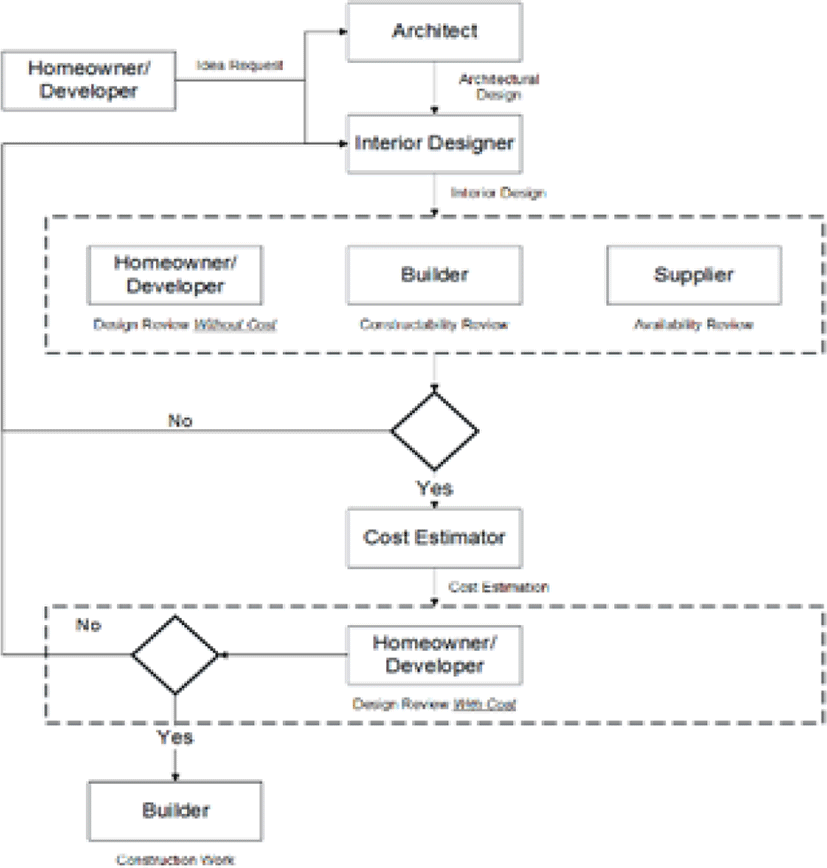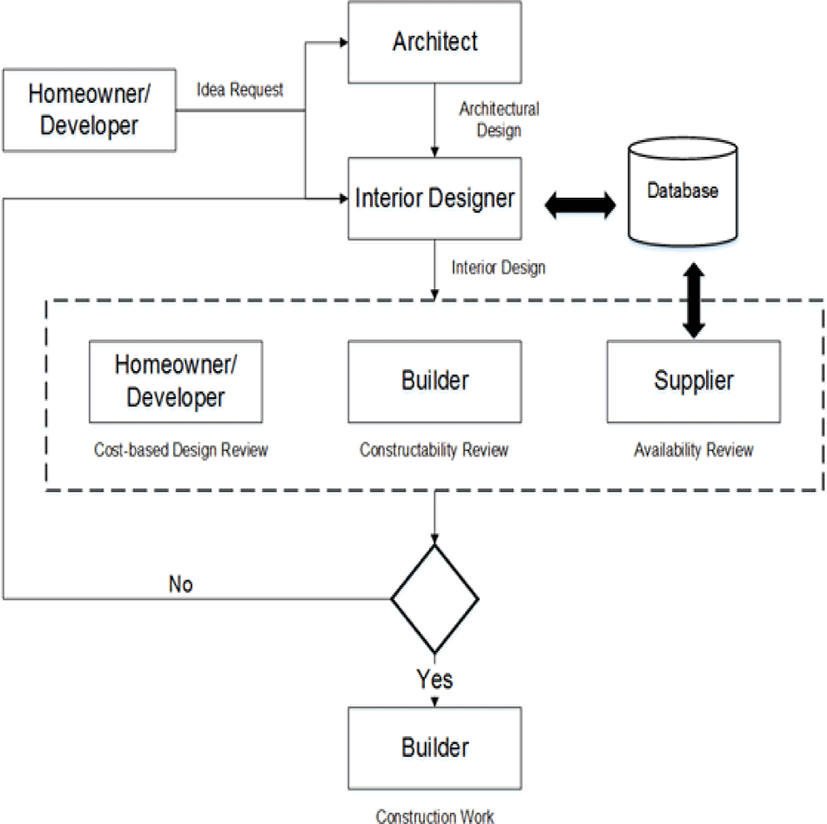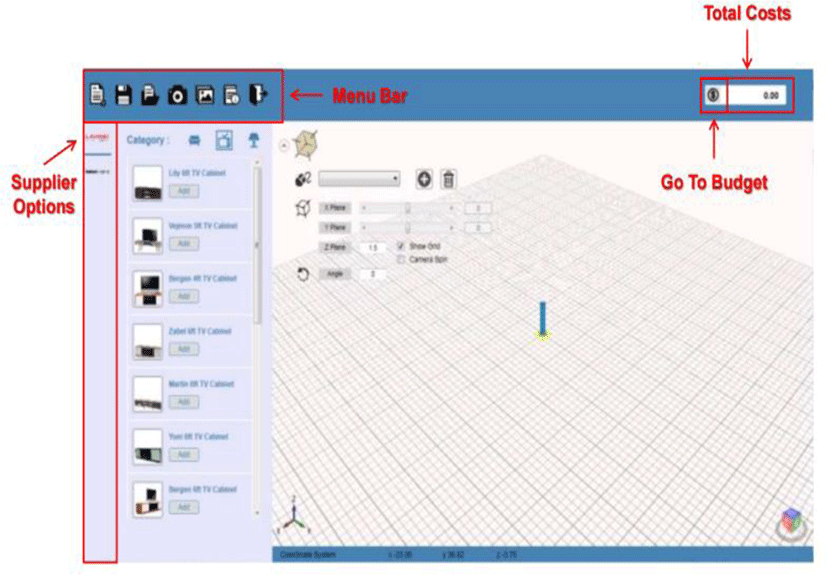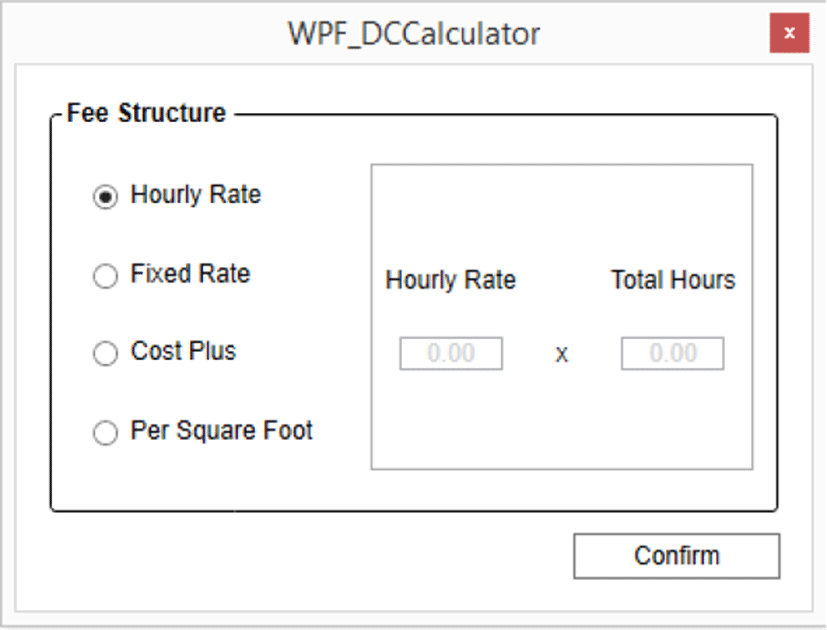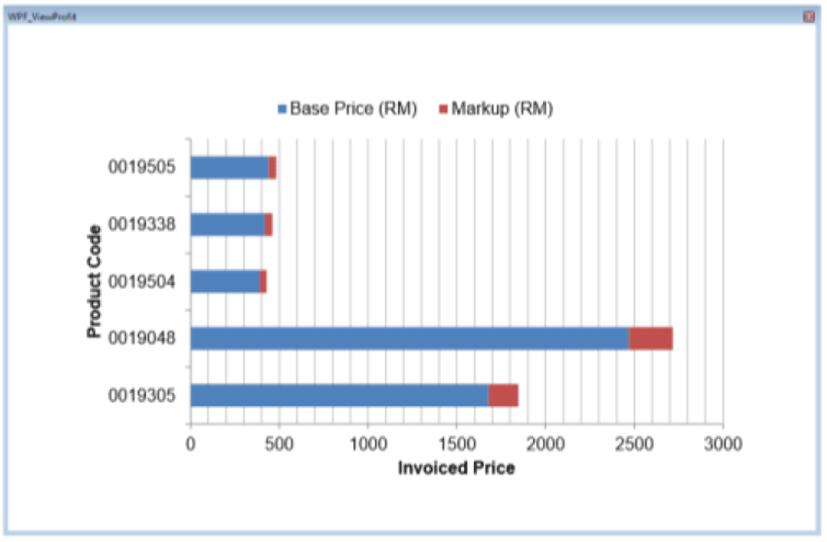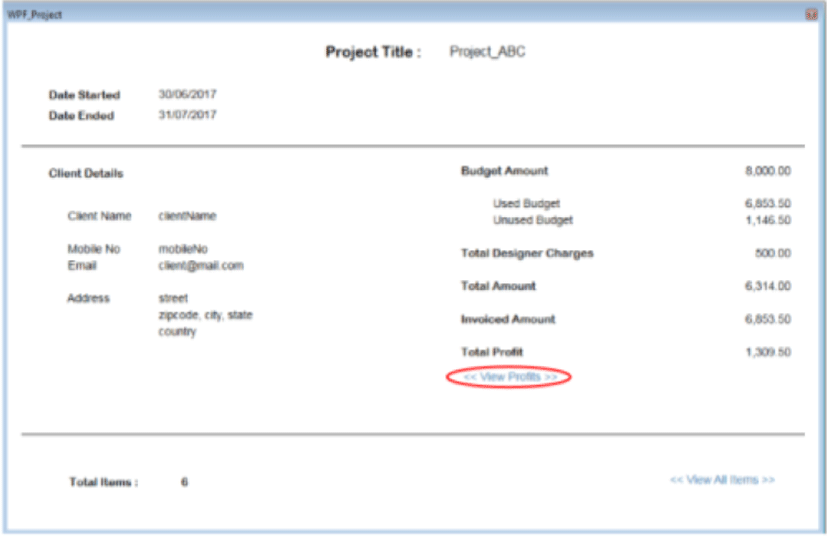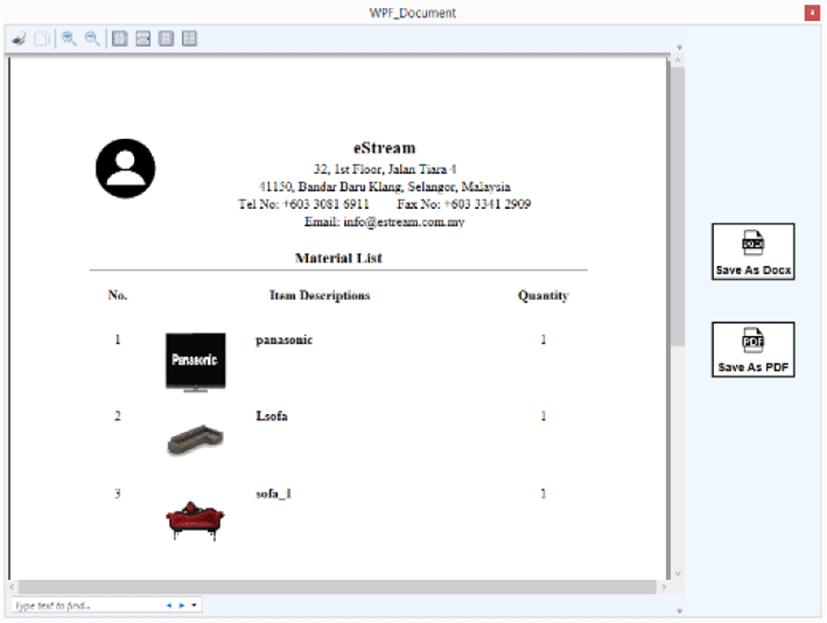I. INTRODUCTION
Interior design phases consist of conception, modelling, review, finalization, detailing and costing as illustrated in Fig. 1. Whereby, interior designer starts a project by developing design concept in terms of theme and style, transforming the design into model, reviewing it with client as well as builder and supplier, adding specific details such as dimensions, texture and color code, and lastly estimating the costs. Hence, any changes made at costing phase will potentially cause an increase in costs and time, forming the problem statement of this project. The significance of the problem statement can be seen especially in a large-scale housing project, where a small change in the costs of a unit plan will then lead to a follow-on effect on hundreds or thousands of uniform unit plans, resulting in the overall project cost overruns [5].
The objective of this project is aimed to devise a cost management module to be included in the proposed application, allowing interior designer to make cost-based decision at the designing phase. This can be achieved by improving the existing interior design procedure as illustrated in Fig. 2 to the improved interior design procedure as illustrated in Fig. 3, in which the overall interior design procedure is being shorten, thus reducing the risks of unnecessary increase in costs and time.
II. LITERATURE REVIEW
IKEA Planning Tools are web based applications using browser plug-in being offered by IKEA for free at their website. Their solutions toward cost estimation in interior design are allowing user to consistently keep track of their total cost and generating a product list at the end of designing. User can then get the products from any IKEA stores at the specific price as listed on the product list. Most importantly, the planner enables user to work with real products with real price data, thus can accurately estimate the total cost [1]. To conclude, IKEA planning tools can generate a product list of IKEA product, while the proposed application can generate a product list of various supplier.
Home Designer Pro is a full-featured software for home design, interior design and outdoor living projects developed by Chief Architect. In their solutions toward cost estimation in interior design, at the end of designing, it will automatically generate a material list for budgeting and planning with the options to calculate by all floors, a room or an area. For example, of calculating by room, the garage or attic can be specified either to be included or excluded in the living area calculation. Besides, it also enables user to export the material list to spreadsheet programs such as Microsoft Excel and even save the screenshot of the material list for different stages of the project to evaluate and compare the differences in cost. Whereas, within the material list, each individual component can be further broken down and assign cost for each of them [4]. To conclude, Home Designer Pro assigns additional costs on each individual component within the material list, while the proposed application assigns additional costs on the overall design such as shipping costs, assembly or installation costs etc.
Designer Logic is a project management software that caters specifically for interior design industry. It is a complex software that links the business of design players, including interior designers, suppliers and contractors and design clients, through accessing separate portal. It provides the interior designers a full project management, the suppliers and contractors to list their products or services and lastly the clients to view their project and either approve or decline them. In their solutions toward cost estimation in interior design, the total cost of the project can be estimated more accurately as the price of products or services are listed by the suppliers or contractors themselves and then again allowing mark-up by interior designer [2]. To conclude, both Designer Logic and the proposed application allows mark-up on product base price.
III. METHODOLOGY
The methodology being proposed in this project is Prototyping Development, categorized under Rapid Application Development (RAD). In brief, prototyping methodology starts off with planning, while analysis, design and implementation phases are performed concurrently and repeatedly in a cycle to produce a system prototype until the system is completed. The main reasons for selecting Prototyping methodology is due to the project short time schedule as well as to quickly refine user requirements. Hence, this is an excellent method in such unclear user requirements and short time schedule.
WPF is chosen over WinForm due to its data binding capabilities as well as highly customizable user interface (UI) component. In WPF, adding a binding between the source and the destination UI element is much simpler. Also, UI component is based on XAML, allowing a complete customization on its look and behavior which is separated from its logic. Somehow, C# language is being used to program the code for its logic. Most important, WPF supports graphics, making it possible to work with 3D objects and shapes.
Spire.Doc for WPF is MS Word component on WPF platform. It is being used to generate document, set up print document as well as save document either in docx or pdf format. Also, it is totally independent component as it does not required Microsoft Office Word to be installed to access the word document processing tasks [3].
SQL Server Express LocalDB engine is used to access the database file (.mdf) after created a service-based database in Visual Studio 2013. It is being used because it can program similarly to SQL Server database but in a lightweight version. Also, by using the designers in Visual Studio 2013, tables and other database objects can be created in ease. In additional, it runs in user mode, hence, fewer prerequisites and no configuration during installation. Whereas, LINQ is being used to deal with the data in the database.
Cost for individual item is estimated by its base price and percentage of mark up as illustrated by the equation below:
To accurately estimate the cost price of the item, additional charges such as shipping charges, assembly or installation charges, and electrical wiring charges can be added to individual item.
The structure of designer charges can be categorized into: Hourly Rate, Fixed Rate, Cost Plus and lastly Per Square Foot. The calculation for each of the category is illustrated in Table 1.
Spire.Doc is used to generate material list through existing Word template and then export as new Word or PDF file. LoadFormFile (string fileName) method is called to load the Word template and SaveToFile (string fileName, FileFormat fileFormat) method is called to export the file as new Word file or PDF file.
Meanwhile, Spire.Doc also provides an easy method Replace (string matchString, string newValue, bool caseSensitive, bool wholeWord) to replace the matched string in the Word document with a new string [3].
IV. GRAPHICAL USER INTERFACE (GUI)
This section is to illustrate the graphical user interface for our prototype, starting from the beginning as shown in Fig. 4 the main window of the prototype. Subsequently, Fig. 5 shows the user interface of budget management, where the used, unused or over budget are presented using a pie chart. The purpose of budget management is to create alert on current budget status. Fig. 6 shows the user interface of designer charges calculator with the purpose to include designer charges costs to the overall costs, so that the total costs is not underestimated. While, Fig. 7 shows the profit over product code chart. Whereas, Fig. 8 shows the user interface of design manager and Fig. 9 show the user interface of material list generation. With that, user can view a particular saved design through design manager and generate material list through material list generation.
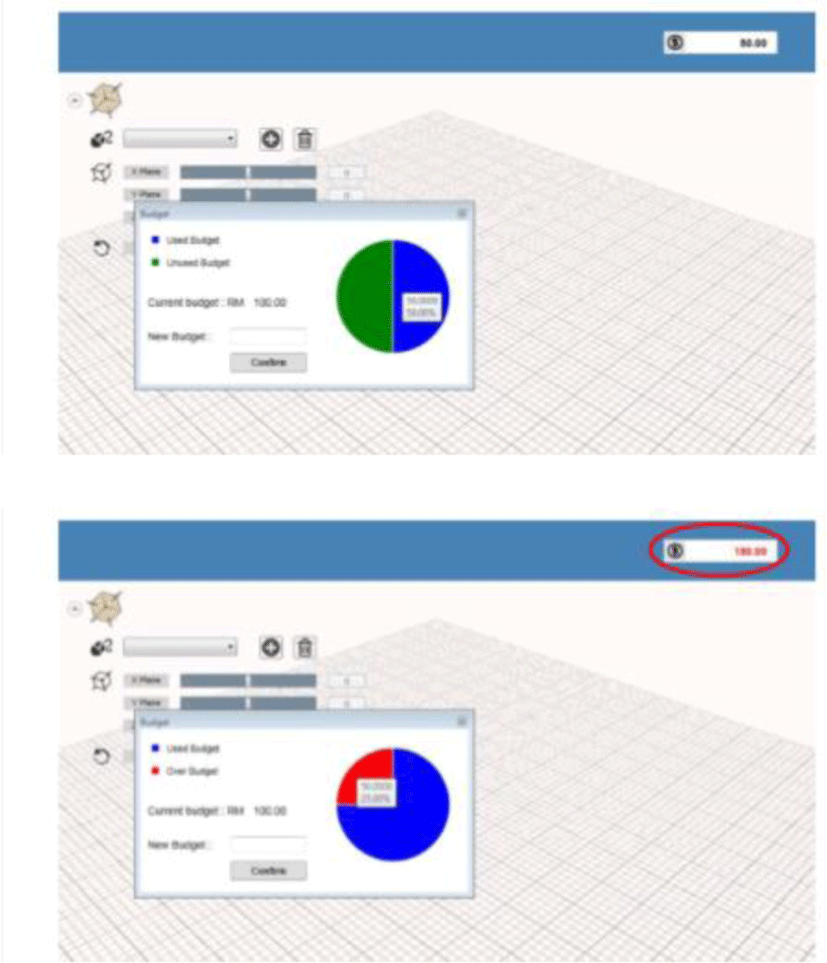
V. TESTING
Testing is conducted to ensure that the proposed prototype is free from defects and errors as well as validating and verifying whether the proposed prototype meets business requirements and user satisfaction. In this project, usability testing and black-box testing are selected to test on the proposed prototype.
In usability testing, the proposed prototype must achieve the five components that are learnability, efficiency, memorability, errors and satisfaction. Whereas, in black-box testing, the proposed prototype must pass the predefined test cases by examining its output based on input.
VI. CONCLUSION
To conclude, the proposed application is aimed to shorten the overall interior design procedure, hence reducing the risks of unnecessary increase in costs and time. This can be achieved by implementing cost management in the designing phase. Therefore, features including total costs update, budget management, cost estimation calculator and material list generation are being proposed in this project as solutions towards cost management in interior design.
The main challenge for this project is the integration of multi-disciplinary areas such as 3D, interior design and cost management. Therefore, much of the time and efforts is required.
Although there is many existing 3D Interior Design software available, only a few of them include cost management module. Most common solution of these software towards costs is through generating a material list at the end of the project as like IKEA Planning Tools and Home Designer Pro. To further improve on the existing solution, our proposed application supports the cost update during the designing phase.









